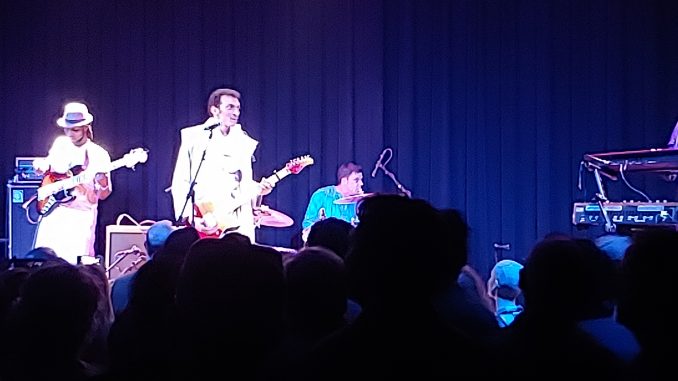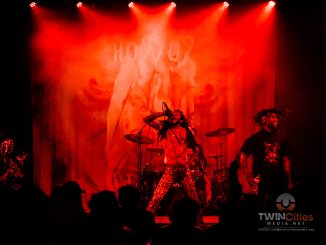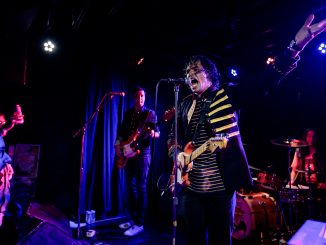
Sometimes I find it a bit stressful trying to scramble between venues when there are multiple bands I want to see. It’s really great when that second act doesn’t go on too early and then really delivers. Bombino’s return trip to The Cedar was a sheer delight once more. He is as remarkable as he is musically unique.
Wednesday night kicked off Bombino’s 2019 North American and European tour in support of his new album Deran. What better place than starting at The Cedar? The place touted by musicians and critics alike as the top world beat venue in the country; with a fan base that knows and loves him?
As I tried to come up with some kind of cohesive narrative describing the show, I realized that would probably still have me writing hours from now. Instead, I’ve decided in this case to simply try to convey a handful of the more powerful impressions and reflections. To hell with concise journalism when you don’t have the words to describe it.
Bombino is a marvel. An true exotic in our part of the world. You know, the land that gave us Fargo and Field of Dreams. He’s the embodiment of the power of music to cross boundaries, cultures and experience. In so many ways, the root of so much of what we listen to these days originated in Africa. When you listen to his brand of self professed “Taureggae” you hear not only the foundation of Jamaican reggae or The Clash. You hear the earliest roots of communal music. Music as way to work long through the day. To tell a story. To celebrate with your tribe when the day is done and there is not an unlimited menu of choices to entertain and insulate us in our own person cocoons. You don’t listen to Bombino play. You participate and share.
Like many of his fans I was introduced to Bombino with the 2013 album Nomad. Black Keys founder and super producer Dan Auerbach heard him and brought him into the studio to concoct a brilliant fusion of West African rhythm and deep blues. A number of sophisticated radio stations like The Current were quick to feature the album and introduce him to a wider audience. This time around, the show seemed a bit more true to his roots. No surprise because this album brought him back home to record; to draw inspiration from his people and way of life.
The great musicians from the deserts and higher latitudes of Africa differ in some significant ways from the more widely known sounds of South Africa. The latter were lifted out of Apartheid by the likes of Peter Gabriel and Paul Simon. Ladysmith Black Mumbazo, Mahlatini & The Mahatella Queens, Miriam Makeba. Vocal and harmonic powerhouses all.
The latter, musicians like Bombino, carry a large dose of Arab/Islamic pedigree. They come from a harsher, arid land. Where people are nomadic simply in order to find the resources they need to survive. Their music is a starker expression and celebration of life. To call what Bombino does as somehow “simpler” is dangerous. The complexity and sophistication is mind-blowing. Notes and rhythms cascade from the stage. It is “simpler” in that music of this type is based on the most basic of instruments. Most of them percussive. The music of West Africa is all about sophisticated poly rhythms. It has stood the test of time for thousands of years.
So what happens when you translate that feeling and approach with electric bass, guitar, keys and drums? Something that is accessible to our Western sensibilities, yet so far from our normal experience. It reminds us of how engaging live music can be. Bombino is not a Taureg playing Westernized music. Nor is he traditional African in the expected sense of the word. He fuses. Does his very own thing. And literally pushes the boundaries not only of the guitar itself, but definable genre as well.
I love to watch great guitar players work. I’ll take the player over a singer every day of the week. No offense. Just a personal opinion. Maybe it’s a belief that in many respects, great singers were born with their instrument in their body. An accident of nature. The guitar player had to go pick it up. And then not only figure out how to make it sing, but to make it sing with a voice that is absolutely its own. A voice, just like a human voice, that is identifiable in a matter of notes.
You name them. The most iconic guitar players all have a unique sound. Hendrix, Van Halen, Joe Walsh, Jerry Garcia, John Lee Hooker, Chuck Berry, David Gilmour, Keith Richards, Santana. That’s by no means meant to be a comprehensive list. It’s just to say nobody sounds anything like them! Bombino is one of those. He plays like heat lightning crackling over the Sahara.
I often find myself looking at a guitar player’s hands. They don’t look like most of us. Of course they don’t. They use them every day in a manner most of us never do. They look like they belong to a workingman or woman. A craftsman. Bombino’s hands are extraordinarily long and lean. No pick. Nails, used to strike; moving both up and down. Five at once; in a manner foreign to how we’re used to seeing the guitar played. His left hand snakes the length of the fret board, never lingering long over any note. I flashed on images of a scorpion scuttling across hot sand. Poised and ready to strike. Faster than you can anticipate.
Think in terms of The Crusades where European culture clashed with that of the Middle East and Northern Africa. Where the knight wielded his heavy broadsword and the defender flashed a quicker and more elegant scimitar. Watching Bombino play his custom Cort, flamed in the colors of a desert sunset, is akin to a scimitar flash.
I recently read a bit of news that refuted the concept of 10,000 steps a day to maintain good health. How many friends do you have with those handy wrist watches that tell you how many steps you managed to accomplish in a day? Turns out the medical profession never made that judgment. It was a marketing campaign designed by the industry that brought us those pesky little counters. Turns out that something like 4,400 is just fine to keep a body healthy and happy. (Good news, that!)
It’s your choice if you opt to head out around the block or spend 75 minutes with Bombino. I know which I’ll choose to get those 4,400 steps. Both times I’ve seen this band, I was struck by how everyone in the audience carves out his or her own little circle of space and simply moves. Grooves within it. This music is wired into the human body. Everything is a rhythm more than it is a melody. Bombino uses his guitar as another means of percussion. You understand that when he turns, engages and jams with his drummer. Most guitar players play off another guitar, or a bass or keys. Bombino is a percussionist with strings.
I loved him the first time I saw him. Even more so this time because the set was a bit more African; more true to his roots. As I circled and stomped in my own little circle I thought of something that could improve the setting. I wanted a roaring fire in the center. Bare feet stamping up little clouds of dust to the rhythm. Embedded in a community. Part of the music itself.
When you don’t need to understand the words, recognize the melodies or predict the flow. When the pace increases like a storyteller relating the sweeping current of warriors pouring down a dune. When the story is conveyed on something other than a literal level. When the music draws you in and hypnotizes you, you have tapped into something basic, primal and utterly human. It is the music of the Motherland. It still calls to us in the hands of Bombino.



